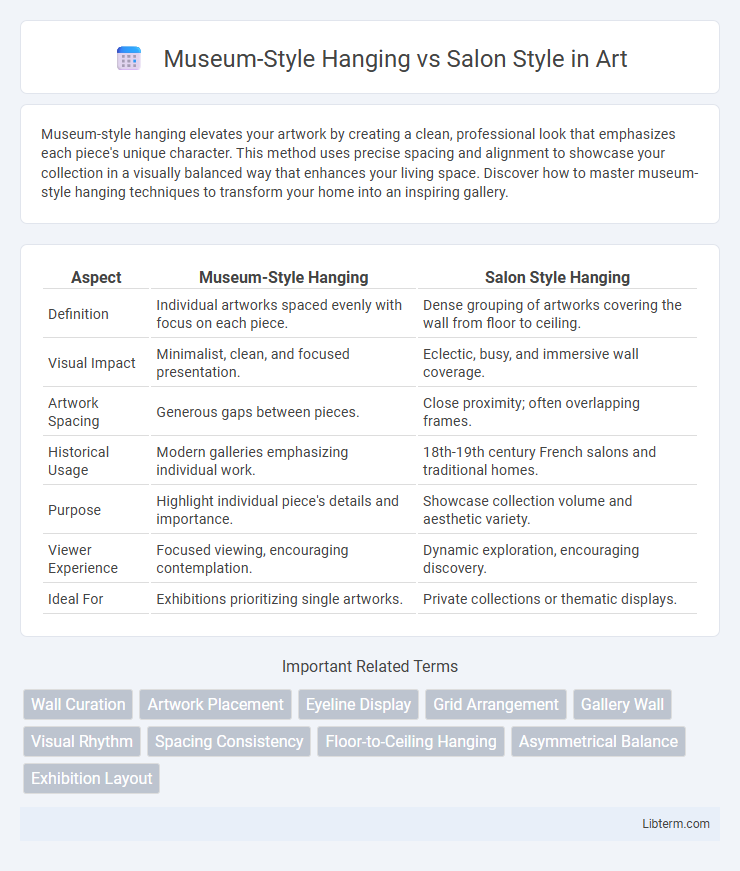Museum-style hanging elevates your artwork by creating a clean, professional look that emphasizes each piece's unique character. This method uses precise spacing and alignment to showcase your collection in a visually balanced way that enhances your living space. Discover how to master museum-style hanging techniques to transform your home into an inspiring gallery.
Table of Comparison
| Aspect | Museum-Style Hanging | Salon Style Hanging |
|---|---|---|
| Definition | Individual artworks spaced evenly with focus on each piece. | Dense grouping of artworks covering the wall from floor to ceiling. |
| Visual Impact | Minimalist, clean, and focused presentation. | Eclectic, busy, and immersive wall coverage. |
| Artwork Spacing | Generous gaps between pieces. | Close proximity; often overlapping frames. |
| Historical Usage | Modern galleries emphasizing individual work. | 18th-19th century French salons and traditional homes. |
| Purpose | Highlight individual piece's details and importance. | Showcase collection volume and aesthetic variety. |
| Viewer Experience | Focused viewing, encouraging contemplation. | Dynamic exploration, encouraging discovery. |
| Ideal For | Exhibitions prioritizing single artworks. | Private collections or thematic displays. |
Introduction to Art Display Styles
Museum-style hanging emphasizes spacious arrangements with substantial gaps between artworks, allowing each piece to stand out individually within galleries or exhibition spaces. Salon style features densely packed, floor-to-ceiling groupings reminiscent of 17th and 18th-century European salons, maximizing wall space for eclectic visual impact. Understanding these distinct art display styles helps curators and collectors tailor presentation methods to enhance viewer engagement and thematic coherence.
What is Museum-Style Hanging?
Museum-style hanging is a curated method of displaying artwork where each piece is spaced individually, emphasizing clarity and focus on each work. This technique prioritizes uniform mounting height, often eye-level, and equal spacing to create a clean, organized presentation. It enhances viewer engagement by allowing detailed appreciation without distraction from neighboring pieces.
Defining Salon Style Hanging
Salon Style Hanging involves arranging artworks closely together from floor to ceiling, creating a dense, visually engaging display reminiscent of 17th-century European salons. This method prioritizes aesthetic richness and narrative cohesion over individual artwork spotlighting, fostering a dynamic gallery experience. Unlike museum-style hanging, which emphasizes spacing and individual piece focus, salon style maximizes wall space and encourages viewers to interpret the collection as an interconnected whole.
Historical Origins of Each Style
Museum-style hanging traces its origins to 19th-century galleries, designed to display each artwork with ample space to emphasize individual pieces and enhance viewer focus. Salon-style hanging emerged from the 17th and 18th-century Parisian salons, where artworks were densely arranged floor to ceiling, showcasing a vast collection and celebrating the social status and eclectic taste of art patrons. These historical contexts influence contemporary exhibition strategies, balancing emphasis on individual works with immersive, narrative-rich groupings.
Visual Impact of Museum-Style vs Salon Style
Museum-style hanging emphasizes individual artwork by spacing pieces evenly with ample negative space, creating a clean, minimalist visual impact that highlights each piece's details and significance. Salon-style hanging densely arranges numerous artworks in close proximity, producing a rich, immersive collage that stimulates visual exploration but can overwhelm the viewer's focus. The distinct visual dynamics of museum-style promote clarity and contemplation, while the salon-style cultivates an energetic, eclectic atmosphere.
Key Principles and Techniques
Museum-style hanging emphasizes uniform spacing, eye-level alignment, and thematic grouping to create a cohesive visual narrative that highlights individual artworks. Salon style features dense, floor-to-ceiling arrangements with varied frame sizes and styles, encouraging eclectic expression and rich visual texture. Key techniques include precise measuring and leveling for museum style, while salon style relies on creative layering and balanced asymmetry to achieve its distinctive look.
Pros and Cons of Museum-Style Hanging
Museum-style hanging offers a clean, uniform display that highlights each artwork individually with ample spacing, enhancing focus and appreciation. This method minimizes visual clutter and protects pieces by reducing risk of damage from crowding, but it can require more wall space and may limit the number of works shown simultaneously. The approach suits curated exhibitions prioritizing quality over quantity, yet might feel less dynamic or personal compared to the densely packed, eclectic arrangement of salon style.
Advantages and Challenges of Salon Style
Salon-style hanging offers the advantage of maximizing wall space by displaying numerous artworks in a dense, layered arrangement, creating an immersive visual impact often favored in eclectic or historical interiors. This style encourages a personalized narrative and dynamic interaction as viewers explore diverse pieces clustered together. Challenges include potential visual clutter and difficulty appreciating individual artworks, requiring careful curation to maintain balance and cohesion within the display.
Choosing the Right Style for Your Space
Museum-style hanging emphasizes uniform spacing, placing artworks at eye level to create a clean, organized display that highlights individual pieces. Salon style arranges artwork densely, often floor-to-ceiling, providing a dynamic, eclectic atmosphere ideal for showcasing a diverse collection in smaller or more personalized spaces. Selecting between these styles depends on room size, wall space, and desired ambiance, with museum style offering minimalism and clarity, while salon style encourages richness and visual storytelling.
Conclusion: Which Hanging Style Suits Your Collection?
Museum-style hanging offers a clean, organized display emphasizing each artwork individually, ideal for focused collections where each piece deserves attention. Salon-style hanging suits eclectic or extensive collections, creating an immersive, visually dynamic environment that encourages detailed exploration. The choice depends on the collection's size, diversity, and desired viewer experience, with museum style enhancing clarity and salon style promoting a rich, layered narrative.
Museum-Style Hanging Infographic

 libterm.com
libterm.com